Repurposing Fashion: A 19th Century Woman’s Guide to Thrift
Emily McCort, 2019 Summer Fashion Archives Intern
Before the advent of the ready to wear market, clothing was very costly, not so much for the labor and time that went into creating a garment, but for the quality of the textiles used. Silk of the finest quality could cost the “equivalent to what a laborer might earn in two years.” [1] While this is only an example of the highest quality of fabrics, it still provides an idea of why these silks were treasured.
By the mid-nineteenth century, technological advances in textile production increased accessibility to a variety of fabrics for the general public, but high quality silks still cost a significant amount. Because of this, oftentimes nineteenth century dresses are constructed from eighteenth century silks. Typically, women would pass pass down dresses to the next generation. This practice of handing down expensive fabrics to be altered and re-purposed through family members was common and why finding unaltered articles of clothing from the eighteenth century and before is rare.
Eighteenth century styles, like the robe à la française, would have yards upon yards of fabric in one dress. This meant that you wouldn’t just be limited to altering an old dress, but you would also have plenty of fabric at your disposal to create new pieces, such as an updated bodice or replacing a skirt panel that may be in poor shape.
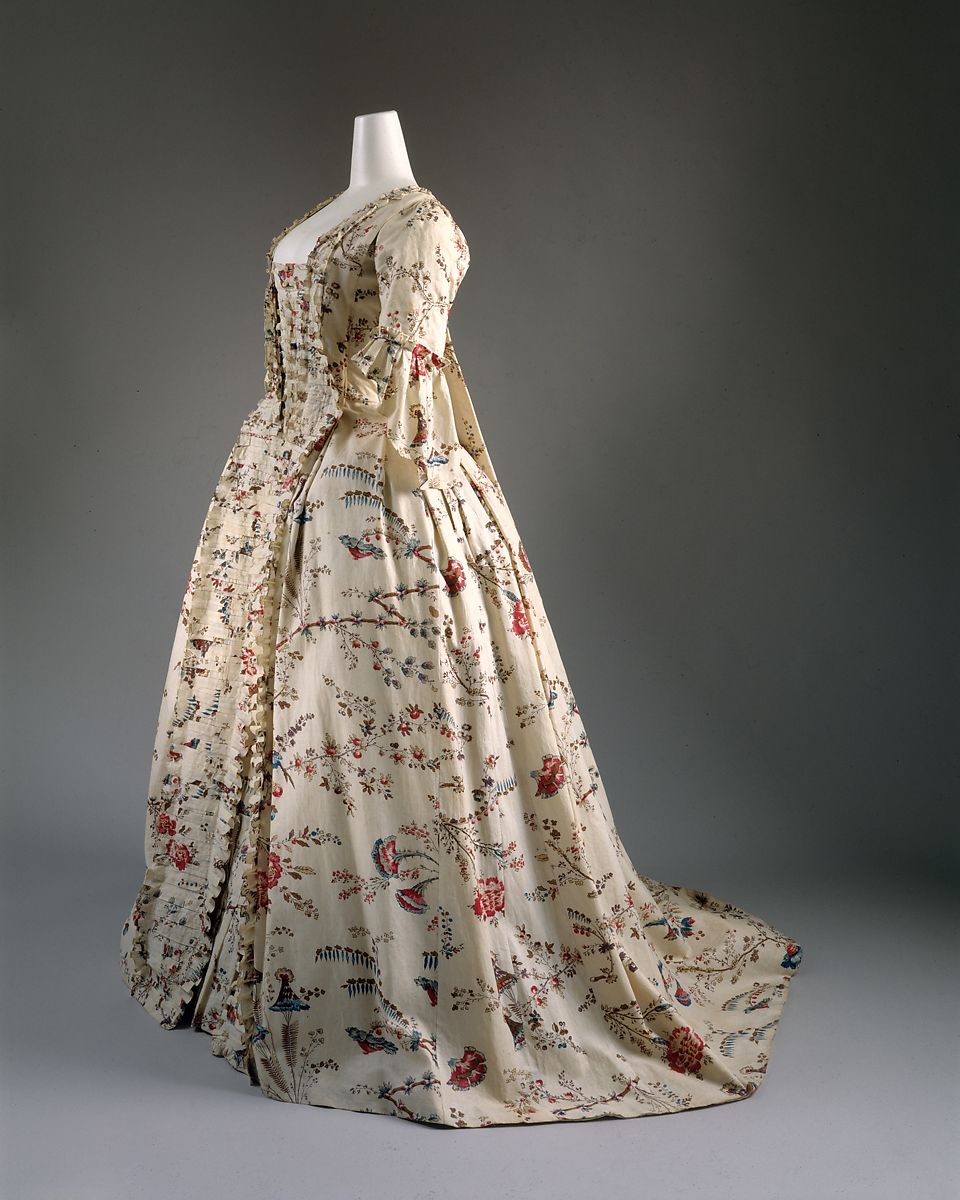 |
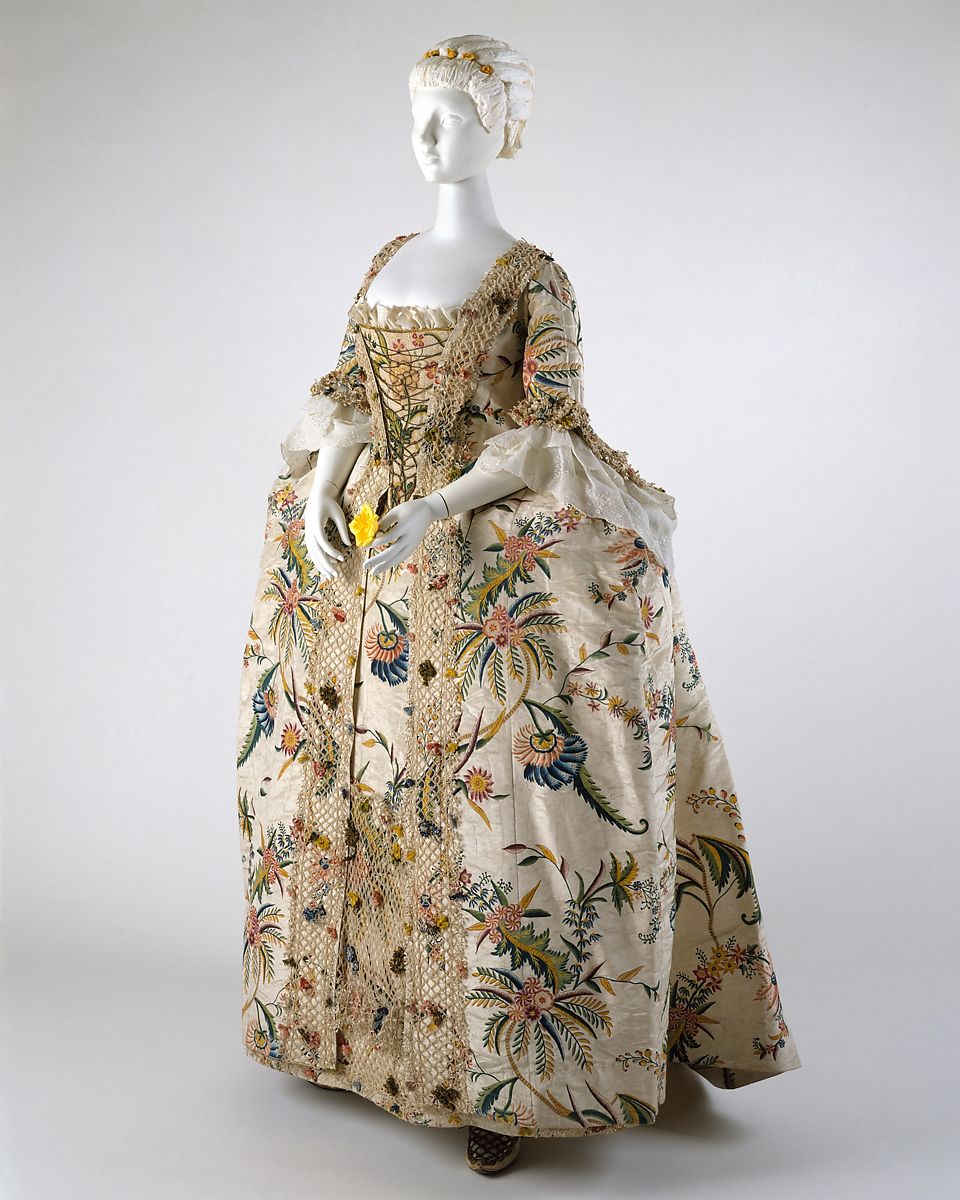 |
| Robe à la Française (1760s), C.I.64.32.3a, b, Metropolitan Museum of Art, Purchase, Irene Lewisohn Bequest, 1964 |
Robe à la Française (1740s), 1995.235a, b, Metropolitan Museum of Art, The Harris Brisbane Dick Fund |
In my research, both from other museums’ collections and examples discovered within the Maryland Historical Society’s Fashion Archives, gowns dated between the 1740s and the 1760s are more commonly recycled than other decades. Oftentimes, examples of eighteenth century reused fabric or altered gowns are found in clothes dating from 1835 through 1845.
How is one able to tell if a gown has been made from fabric dating from a previous century?
Pattern can tell a lot about from which decade or century a fabric or dress originates. While there are always exceptions to the rule, by looking at what patterns were popular and available from a certain time, conclusions can be made as to whether a gown has been altered from a previous century’s style.
In the eighteenth century, woven patterned silks typically fell into two categories – la petite tire and la grande tire. Les petites tires were silks with small patterns and usually used less than 5 colors. Les grandes tires, on the other hand, were silks with large repeating patterns, a variety of colors, and used a mixture of textures to create more dimensional looks. Beginning in the middle of the 1740s and ending in the 1770s, la grande tire had, “woven designs in which single bouquets of flowers or vignettes of little scenes were scattered across meandering patterns of flowers and stems, furs and flounced lace – anything that would scroll sinuously and asymmetrically across the expanse of fabric.”[1]. By the end of the century, these designs had reduced in size to smaller patterns and motifs.
 |
| Detail of silk brocade that is in the style of la grande tire. |
| Maryland Historical Society, Gift of Mrs. Mary Jewin Wethered Clark, 1981.61.1-.3 |
Meanwhile, the late 1830s and 1840s see a preference for “darker shades in dress and a lack of surface ornamentation, as well as a general neatness and unfussiness.”[2] The highly decorated silks of the eighteenth century may seem like a poor fabric choice for the relatively subdued mid-nineteenth century look, but again, we see examples of women altering fabric even further to match the current styles. In a dress from the 1840s in the Victoria and Albert collection, “stitch marks on the skirt and bodice show where the original 1770s gown has been unpicked and the applied decoration removed.” [3] Furthermore, these silks would have most likely been used in evening or wedding dresses where finer fabrics and ornamentation would have been more appropriate.
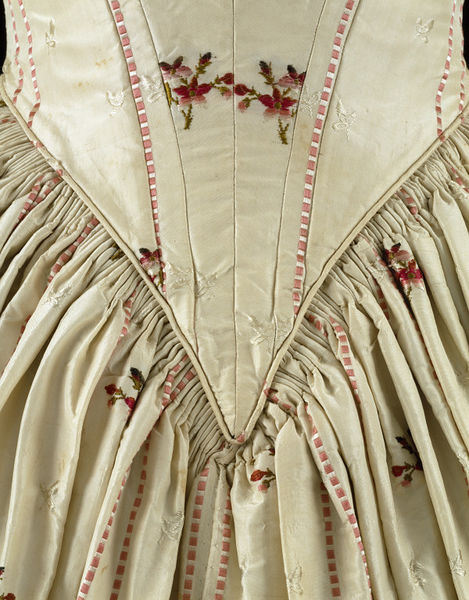 |
| Detail of 1840s Evening Dress with 1770s fabric. |
|
Evening Dress (1840s), T.854-1974, Victoria & Albert Museum, Gift of Mrs C. Shaw |
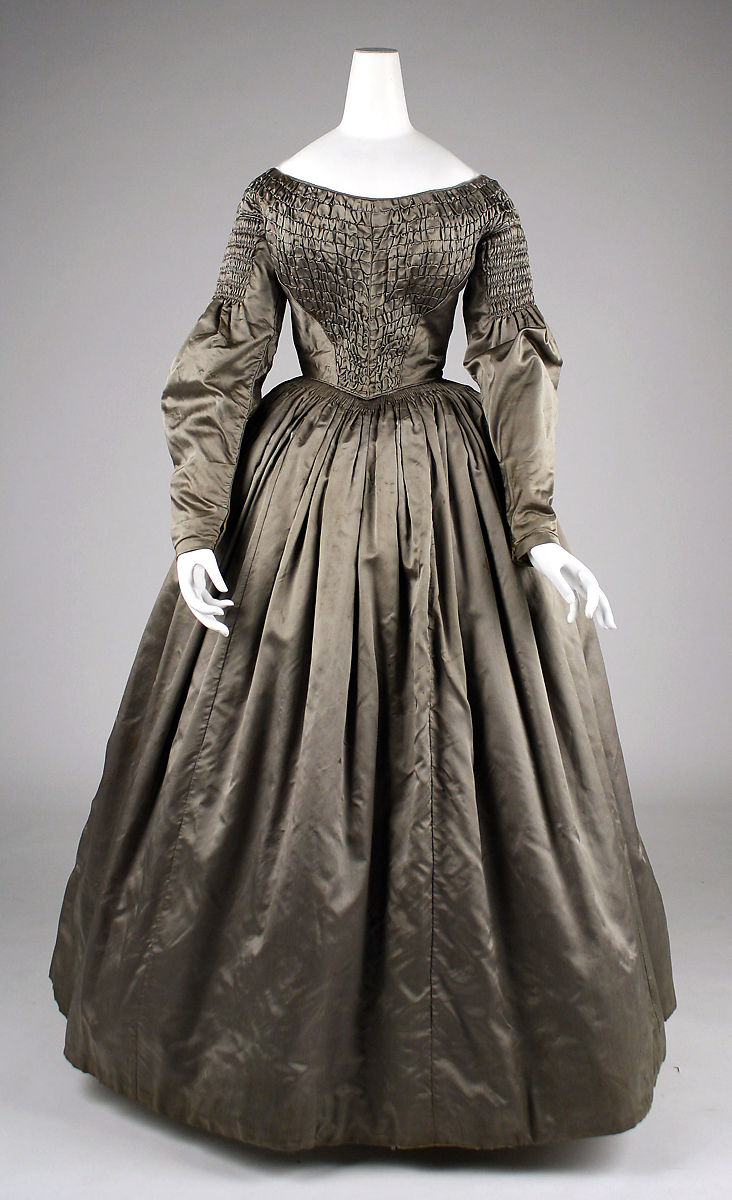 |
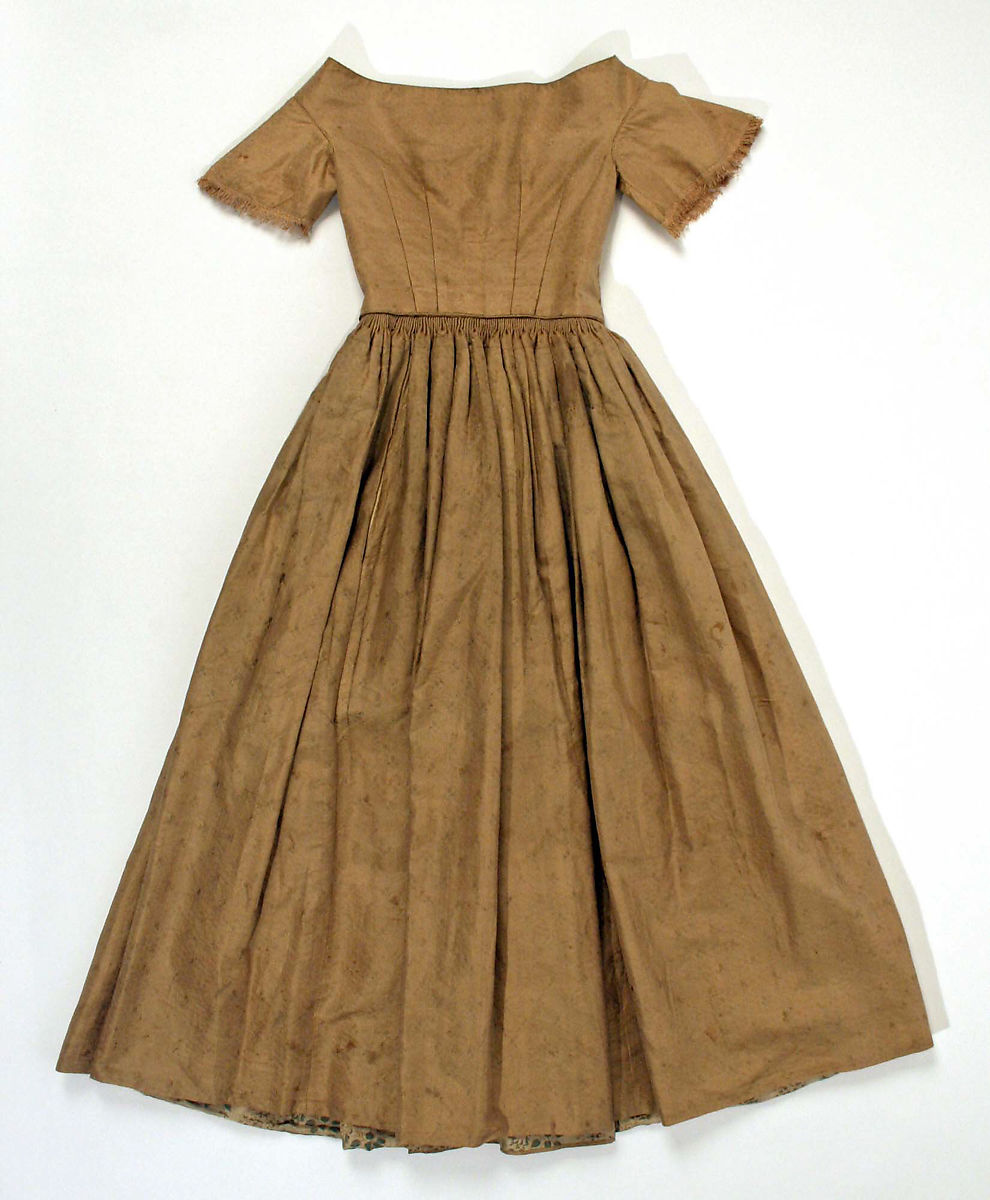 |
| Examples of the subdued colors and minimal adornment popular in the 1840s. | |
| Dress (1840s), 2008.19, Metropolitan Museum of Art, Purchase, Judith and Ira Sommer Gift |
Dress (1840s), 1978.314.3, The Metropolitan Museum of Art, Gift of Mr. and Mrs. John W. Balet |
 |
|
Ensemble (1831-35), 41.126a, b, Metropolitan Museum of Art,The Rogers Fund |
Despite these differences in ornamentation, similarities in silhouette existed between the two centuries which made reconstructing a dress from the 1740s possible in the 1840s. As the Victoria and Albert Museum in London points out, “the 1840s vogue for long bodices and full skirts meant that there were stylistic similarities between the newest fashions and those of the previous century. Alteration was therefore viable. It was also much cheaper to restyle an old dress than buy a new silk of this quality.” [3] The creativity that went into altering a gown to fit a style 100 years after it was originally made is astonishing. These re-purposed gowns are also amazing examples of fashion’s cyclical nature.
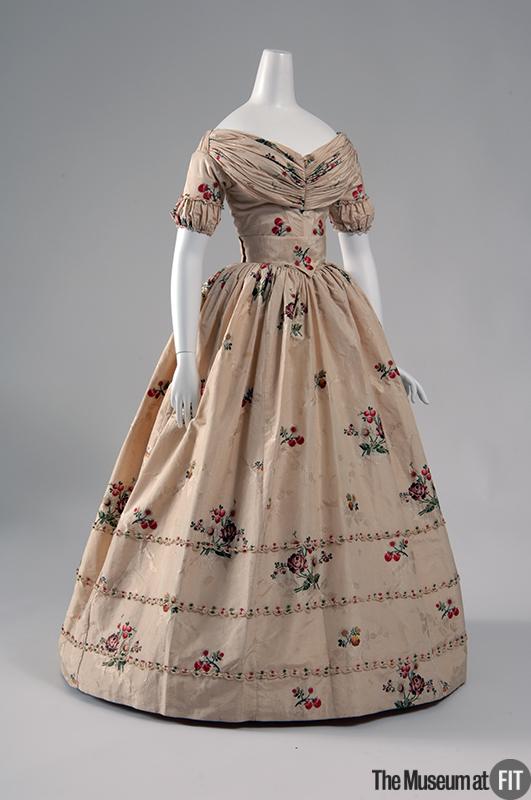 Example of a 1760s dress altered to an 1840s dress Example of a 1760s dress altered to an 1840s dress |
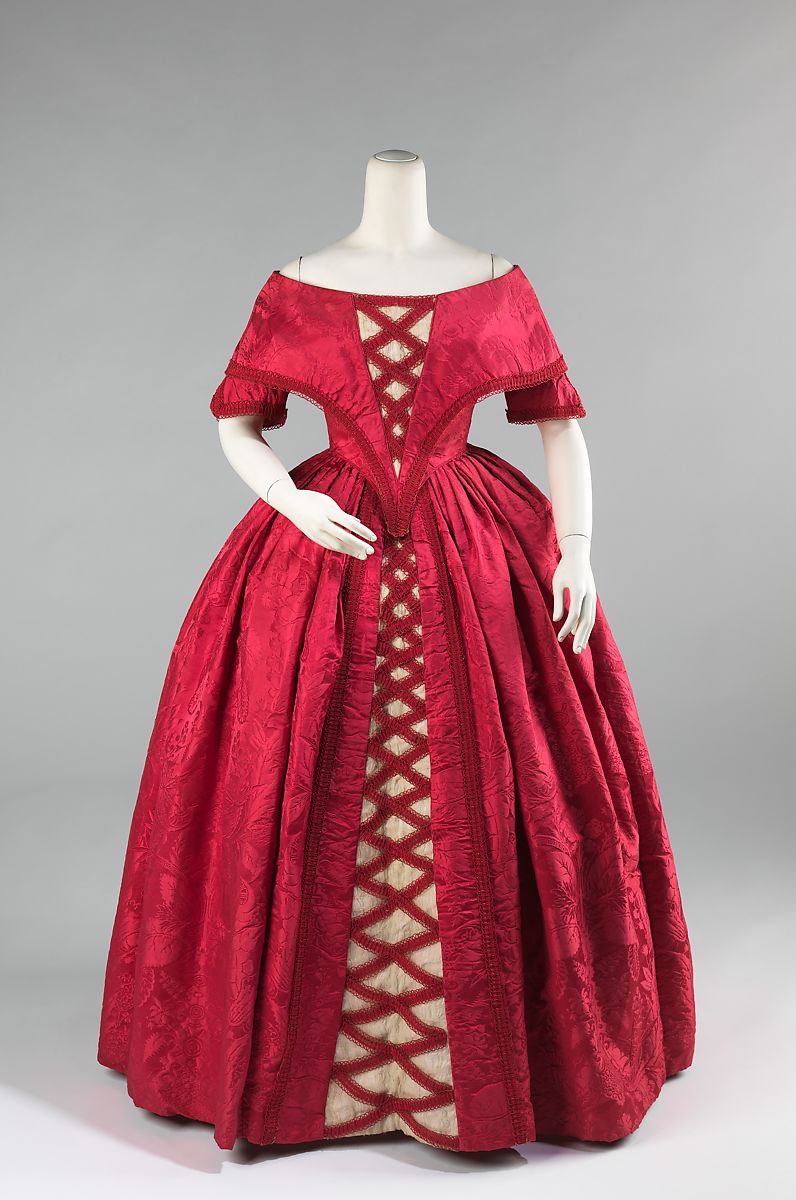 Example of a 1740s dress altered to an 1842 ball gown Example of a 1740s dress altered to an 1842 ball gown |
|
Dress (1840s), P87.20.7, Museum at FIT, Museum Purchase |
Ball Gown (1842), 2009.300.1007, Brooklyn Museum Costume Collection at The Metropolitan Museum of Art, Gift of the Brooklyn Museum, 2009; Designated Purchase Fund |
 |
 |
 |
| Example of a 1750 -60 dress altered to an 1840s dress |
| Maryland Historical Society, Gift of Mrs. Mary Jewin Wethered Clark, 1981.61.1-.3 |
While this practice of recycling eighteenth century dresses means that fewer of these original garments survive, there is an interesting history to be explored in how women’s resourceful thrift kept up with current trends. Instead of letting a gown rest in a trunk forgotten in the attic, these dresses were given new life throughout the centuries. They are true examples of how clothing and fashion can stand the test of time.
Sources:
[1] Miller, Lesley Ellis. Selling Silks A Merchant’s Sample Book 1764 (South Kensington: V&A Publishing, 2014).
[2] Edwards, Lydia. How to Read a Dress (London, England: Bloomsbury Press, 2017).
[3] Victoria & Albert Museum. “Evening Dress 1840s.” http://collections.vam.ac.uk/item/O117708/evening-dress-unknown/.
Other Resources:
Gordon, Jennifer Farley, and Colleen Hill. Sustainable Fashion: Past, Present and Future (London, England: Bloomsbury Publishing, 2014)

